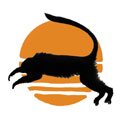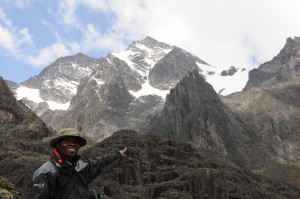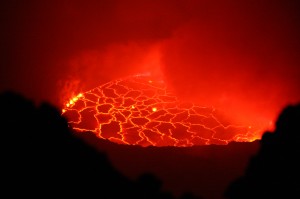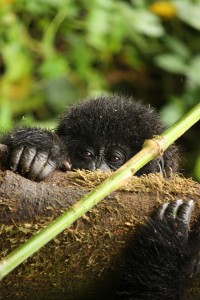Recently I gave several talks on Virunga National Park (some as an introduction to private screenings of the “Virunga” documentary) and I thought that a compilation of these texts could be interesting for the blog as well:
“Virunga” is a kind of “magic”, especially for the people who have been there or who know somewhat more about the place. Virunga grabs you, holds you. It is overwhelming. The natural beauty is just stunning. Everything is above any imagination in Virunga. That is true for the very best as, unfortunately, also for the very worst you can imagine. This wonderful region “East Congo” has been a troubled place since long.
This is a picture of the North of the Virunga National Park. Such mountains with glaciers and snow were probably not the first images you expected when thinking about this Park in Central Africa.
These are the Rwenzori mountains, also called the “Mountains of the Moon”. Some of the summits are above 5,000 meters. They intrigued explorers and adventurers for decades, for centuries. Mountains of the Moon – this name refers to the eternal snow, the glaciers on the summits. But… the snow is not that “eternal” at all. By 2025 there may be no more glaciers here anymore. We feel that this is probably the only problem, the only challenge, the only threat to Virunga National Park for which we can do nothing.
The rest, is something our colleagues on the ground, the country, the international community can work on. Whether it is political unrest, deforestation, rebels, poverty, poachers, unsustainable industries – there are solutions to be found for these problems.
From the summits of one of the greatest mountains in Africa, the Park can also take you to Lake Edward with its great hippo populations and to savannah with elephants. There are many different altitudes, different climates, different landscapes in the Virunga National Park. It is home to a very wide range of birds, reptiles and mammals. There is an extremely rich biodiversity.
Further down to the South of the 300 kilometers long Park, you reach the volcanoes. There are 8 Virunga volcanoes in the border region of the three countries DRC, Rwanda, Uganda. Two of the Congolese volcanoes are active: the Nyiragongo and the Nyamuragira. The Nyiragongo has even an impressive, permanent lava lake on the top. It allows you to have a glimpse in the inner earth. Mind blowing! The volcanoes are actually the reason for Virunga’s name. In Kinyarwanda, a local language, “ibirunga” means “mountains of fire” or “volcanoes”.
A central volcano for Virunga is the Mikeno. In the Southern part of the Park we have the so called “Mikeno sector”, which is home to the most famous inhabitants of the Park: the mountain gorillas. Only 880 are left in the world and about a quarter live in the DRC. The other approximately 75% are in the neighbouring Volcanoes Park in Rwanda and the Bwindi Park in Uganda.
Although Virunga National Park is not as famous as Kruger, Masai Mara or Serengeti, it is the oldest and most bio-diverse African park! An UNESCO world heritage site. Whereas “Virunga” is not the most familiar name to most people, a reference to “Gorillas in the Mist” makes a bell ring! The book and movie about the life of Dian Fossey made the world aware of these amazing great apes in the 1980’s.
Hopefully the new documentary “Virunga” will draw attention to the region once again. It has been a “forgotten park”, but we would like to give Virunga its deserved place on the world map. The documentary (please find the trailer here) is part of a global campaign. A campaign to raise global awareness. And to raise funds to bring peace and prosperity through sustainable development in the region of Virunga National Park. As Human Rights Watch state: “Virunga is central to building lasting peace. Stability to the Park will help bring stability to eastern Congo”
The documentary is at moments quite shocking. Even a kind of discouraging. Could East Congo ever overcome the instability, the corruption? How to deal with issues around oil and extractive industries? Is lasting peace possible? But just take a look at neighbouring Rwanda; during the genocide just 20 years ago (1994) it was a true hell on earth. Now, the country is rebuilt. A “Wirtschaftswunder” in Africa? Investors are there, visitors come. They have a flourishing tourist industry. Probably I’m biased, but also looking at the facts on what the Virunga National Park has on offer, the tourism potential in East Congo is much bigger than in Rwanda. There are massive opportunities in the East Congo region. Virunga focuses on the following business cases:
1. Nature tourism
2. Hydropower (a rural electrification programme: from 3Mw to more than 80Mw in a decade)
3. Agriculture
4. Sustainable fisheries in the Lake Edward
More to be found in other blog posts and on the Virunga website.



